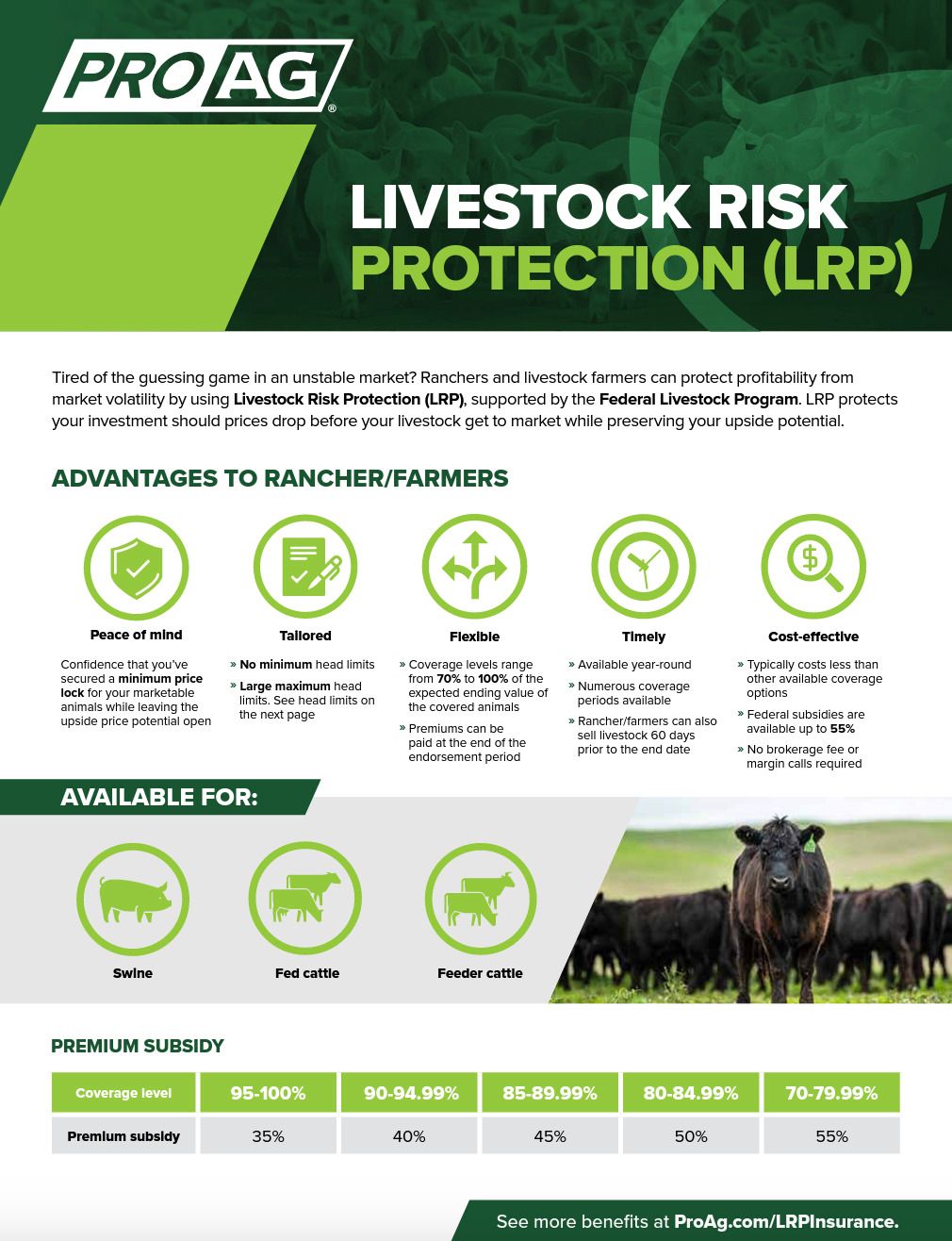Strategic Collaborations for Durability: Bagley Risk Management
Strategic Collaborations for Durability: Bagley Risk Management
Blog Article
Comprehending Livestock Threat Protection (LRP) Insurance: A Comprehensive Guide
Browsing the world of livestock threat defense (LRP) insurance can be a complicated undertaking for lots of in the agricultural industry. This sort of insurance uses a safeguard against market variations and unforeseen circumstances that could affect animals manufacturers. By understanding the complexities of LRP insurance, producers can make informed decisions that might guard their procedures from economic dangers. From how LRP insurance coverage operates to the various protection choices offered, there is much to reveal in this comprehensive overview that might possibly shape the method animals producers approach threat monitoring in their services.

Just How LRP Insurance Functions
Sometimes, comprehending the mechanics of Animals Threat Defense (LRP) insurance policy can be complicated, yet damaging down just how it works can offer clearness for ranchers and farmers. LRP insurance is a threat management tool designed to protect animals producers versus unforeseen cost decreases. It's important to keep in mind that LRP insurance policy is not a revenue assurance; instead, it concentrates entirely on price risk security.
Eligibility and Coverage Options

When it concerns insurance coverage choices, LRP insurance offers manufacturers the flexibility to select the insurance coverage level, insurance coverage period, and recommendations that finest suit their threat management needs. Insurance coverage degrees normally vary from 70% to 100% of the expected finishing value of the insured animals. Producers can likewise select protection durations that align with their manufacturing cycle, whether they are insuring feeder livestock, fed cattle, swine, or lamb. Endorsements such as price danger protection can further personalize insurance coverage to protect against adverse market variations. By comprehending the qualification criteria and insurance coverage choices readily available, livestock manufacturers can make informed choices to handle risk successfully.
Advantages And Disadvantages of LRP Insurance Coverage
When reviewing Livestock Danger Protection (LRP) insurance, it is crucial for animals producers to evaluate the downsides and advantages intrinsic in this risk management device.

One of the key advantages of LRP insurance policy is its capacity to offer defense versus a decline in animals rates. Furthermore, LRP insurance uses a degree of adaptability, permitting manufacturers to tailor coverage degrees and plan periods to match their certain demands.
One constraint of LRP insurance policy is that it does not secure against all kinds of dangers, such as see here illness break outs or natural disasters. It is essential for manufacturers to carefully analyze their private threat direct exposure and economic situation to establish if LRP insurance coverage is the appropriate risk monitoring tool for their procedure.
Comprehending LRP Insurance Policy Premiums

Tips for Taking Full Advantage Of LRP Perks
Optimizing the advantages of Animals Danger Protection (LRP) insurance policy requires tactical planning and proactive risk administration - Bagley Risk Management. To make the many of your LRP insurance coverage, consider the following suggestions:
Regularly Assess Market Conditions: Remain educated concerning market trends and cost fluctuations in the livestock industry. By monitoring these factors, you can make educated decisions about when to buy LRP insurance coverage to secure against possible losses.
Set Realistic Protection Levels: When selecting protection degrees, click here for more consider your manufacturing expenses, market worth of livestock, and possible risks - Bagley Risk Management. Setting practical coverage levels ensures that you are adequately safeguarded without overpaying for unneeded insurance policy
Diversify Your Protection: Rather than relying solely on LRP insurance policy, think about diversifying your danger monitoring techniques. Combining LRP with other threat administration devices such as futures contracts or options can give thorough coverage versus market unpredictabilities.
Evaluation and Readjust Coverage Consistently: As market problems alter, regularly review your LRP insurance coverage to ensure it aligns with your present risk exposure. Adjusting coverage degrees and timing of acquisitions can assist enhance your danger security strategy. By following these suggestions, you can make the most of the benefits of LRP insurance coverage and secure your livestock operation against unpredicted dangers.
Verdict
Finally, animals threat security (LRP) insurance coverage is a beneficial tool for farmers to handle the economic risks related to their livestock operations. By comprehending just how LRP functions, eligibility and insurance coverage choices, as well as the advantages and disadvantages of this insurance, farmers site can make educated choices to secure their resources. By carefully thinking about LRP premiums and executing techniques to make best use of advantages, farmers can mitigate possible losses and ensure the sustainability of their operations.
Animals manufacturers interested in obtaining Animals Danger Security (LRP) insurance coverage can discover a range of qualification requirements and insurance coverage alternatives customized to their details animals operations.When it comes to coverage alternatives, LRP insurance coverage uses manufacturers the flexibility to pick the protection degree, coverage duration, and recommendations that finest suit their threat management requirements.To understand the details of Animals Risk Security (LRP) insurance fully, recognizing the elements influencing LRP insurance costs is important. LRP insurance policy premiums are established by various components, consisting of the coverage degree selected, the anticipated price of livestock at the end of the coverage duration, the kind of livestock being insured, and the length of the protection duration.Evaluation and Adjust Protection Regularly: As market conditions change, periodically examine your LRP coverage to ensure it straightens with your current danger direct exposure.
Report this page